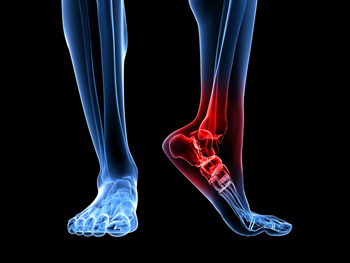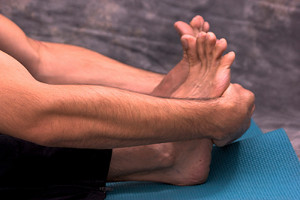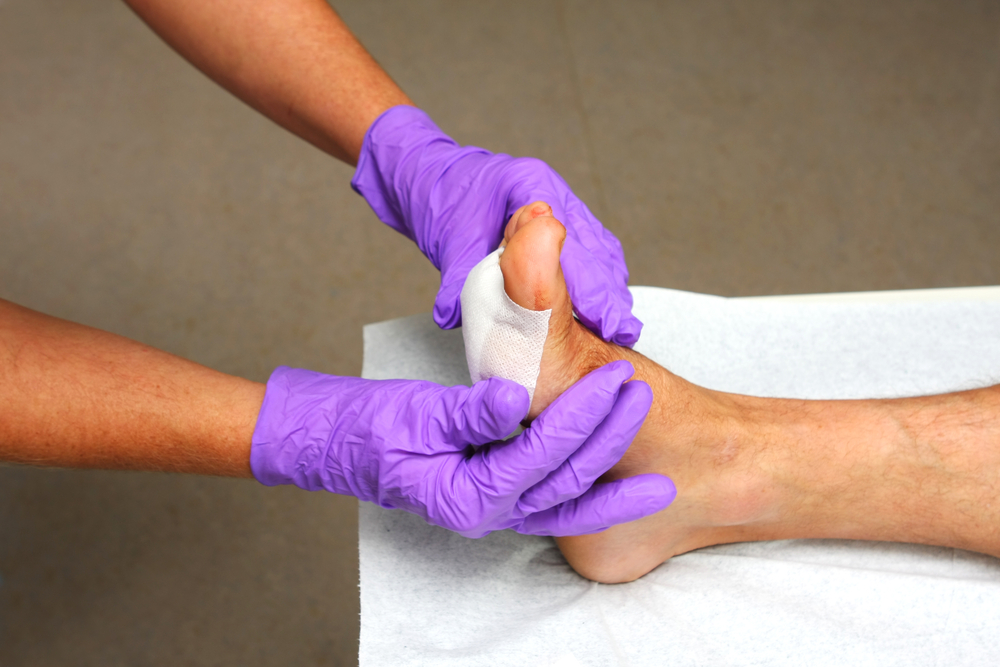Items filtered by date: February 2020
Excessively Sweaty Feet
 An uncomfortable ailment that causes the feet to sweat excessively is referred to as plantar hyperhidrosis. This condition may lead to foot odor, as well as medical conditions that can include toenail fungus or athlete’s foot. Hyperhidrosis occurs as a result of sweat glands that produce large quantities of sweat, which in turn, may cause embarrassment among affected patients. Research has indicated there may be methods that can be implemented which can help to manage this condition. These can include wearing the right socks for the corresponding season, choosing shoes that are made out of breathable materials, and applying an antifungal powder on a regular basis. Additionally, it may be beneficial to drink plenty of water, as this may help to maintain the normal body temperature. If you are afflicted with plantar hyperhidrosis, it is advised that you are under the care of a podiatrist for professional care and treatment.
An uncomfortable ailment that causes the feet to sweat excessively is referred to as plantar hyperhidrosis. This condition may lead to foot odor, as well as medical conditions that can include toenail fungus or athlete’s foot. Hyperhidrosis occurs as a result of sweat glands that produce large quantities of sweat, which in turn, may cause embarrassment among affected patients. Research has indicated there may be methods that can be implemented which can help to manage this condition. These can include wearing the right socks for the corresponding season, choosing shoes that are made out of breathable materials, and applying an antifungal powder on a regular basis. Additionally, it may be beneficial to drink plenty of water, as this may help to maintain the normal body temperature. If you are afflicted with plantar hyperhidrosis, it is advised that you are under the care of a podiatrist for professional care and treatment.
If you are suffering from hyperhidrosis contact Dr. Kendall Blackwell of InStride Wilson Podiatry Associates. Our doctor can provide the care you need to attend to all of your foot and ankle needs.
Hyperhidrosis of the Feet
Hyperhidrosis is a rare disorder that can cause people to have excessive sweating of their feet. This can usually occur all on its own without rigorous activity involved. People who suffer from hyperhidrosis may also experience sweaty palms.
Although it is said that sweating is a healthy process meant to cool down the body temperature and to maintain a proper internal temperature, hyperhidrosis may prove to be a huge hindrance on a person’s everyday life.
Plantar hyperhidrosis is considered to be the main form of hyperhidrosis. Secondary hyperhidrosis can refer to sweating that occurs in areas other than the feet or hands and armpits. Often this may be a sign of it being related to another medical condition such as menopause, hyperthyroidism and even Parkinson’s disease.
In order to alleviate this condition, it is important to see your doctor so that they may prescribe the necessary medications so that you can begin to live a normal life again. If this is left untreated, it is said that it will persist throughout an individual’s life.
A last resort approach would be surgery, but it is best to speak with your doctor to find out what may be the best treatment for you.
If you have any questions please feel free to contact our office located in Wilson, NC . We offer the newest diagnostic and treatment technologies for all your foot and ankle needs.
The Function of the Plantar Fascia
 The plantar fascia is a band of tissue that connects the heel to the toes. Strained ligaments in this part of the foot may cause a condition to occur that is referred to as plantar fasciitis. This ailment is considered to be the most common cause of foot pain in adults. The plantar fascia helps to provide the necessary support while performing running and jumping activities, and can cause severe pain and discomfort if it becomes inflamed. Plantar fasciitis may happen for a variety of reasons. These may include experiencing a foot injury, wearing shoes that do not fit correctly, or from standing for extended periods of time throughout the day. Common symptoms that patients may feel can consist of heel pain, which may be more prominent early in the morning. There are several types of treatments available, and it is suggested that you consult with a podiatrist who can help you to determine which one is the best one for you.
The plantar fascia is a band of tissue that connects the heel to the toes. Strained ligaments in this part of the foot may cause a condition to occur that is referred to as plantar fasciitis. This ailment is considered to be the most common cause of foot pain in adults. The plantar fascia helps to provide the necessary support while performing running and jumping activities, and can cause severe pain and discomfort if it becomes inflamed. Plantar fasciitis may happen for a variety of reasons. These may include experiencing a foot injury, wearing shoes that do not fit correctly, or from standing for extended periods of time throughout the day. Common symptoms that patients may feel can consist of heel pain, which may be more prominent early in the morning. There are several types of treatments available, and it is suggested that you consult with a podiatrist who can help you to determine which one is the best one for you.
Plantar fasciitis is a common foot condition that is often caused by a strain injury. If you are experiencing heel pain or symptoms of plantar fasciitis, contact Dr. Kendall Blackwell from InStride Wilson Podiatry Associates. Our doctor can provide the care you need to keep you pain-free and on your feet.
What Is Plantar Fasciitis?
Plantar fasciitis is one of the most common causes of heel pain. The plantar fascia is a ligament that connects your heel to the front of your foot. When this ligament becomes inflamed, plantar fasciitis is the result. If you have plantar fasciitis you will have a stabbing pain that usually occurs with your first steps in the morning. As the day progresses and you walk around more, this pain will start to disappear, but it will return after long periods of standing or sitting.
What Causes Plantar Fasciitis?
- Excessive running
- Having high arches in your feet
- Other foot issues such as flat feet
- Pregnancy (due to the sudden weight gain)
- Being on your feet very often
There are some risk factors that may make you more likely to develop plantar fasciitis compared to others. The condition most commonly affects adults between the ages of 40 and 60. It also tends to affect people who are obese because the extra pounds result in extra stress being placed on the plantar fascia.
Prevention
- Take good care of your feet – Wear shoes that have good arch support and heel cushioning.
- Maintain a healthy weight
- If you are a runner, alternate running with other sports that won’t cause heel pain
There are a variety of treatment options available for plantar fasciitis along with the pain that accompanies it. Additionally, physical therapy is a very important component in the treatment process. It is important that you meet with your podiatrist to determine which treatment option is best for you.
If you have any questions, please feel free to contact our office located in Wilson, NC . We offer the newest diagnostic and treatment technologies for all your foot care needs.
What Benefits Are Gained From Stretching The Feet?
 People who enjoy running or jogging as their chosen sport or hobby are generally aware of the necessity to stretch the feet and ankles. Performing correct stretching techniques may help to keep the feet healthy and strong. An effective stretch can consist of picking up small objects with your toes, and placing them in a nearby cup. This can also help to improve flexibility. Balance may be improved by standing on a smooth surface on one foot, followed by changing to an uneven surface, such as a mini trampoline. This will typically help the overall body as well as the feet and ankles. If you would like additional information about the benefits of stretching the feet, please speak with a podiatrist.
People who enjoy running or jogging as their chosen sport or hobby are generally aware of the necessity to stretch the feet and ankles. Performing correct stretching techniques may help to keep the feet healthy and strong. An effective stretch can consist of picking up small objects with your toes, and placing them in a nearby cup. This can also help to improve flexibility. Balance may be improved by standing on a smooth surface on one foot, followed by changing to an uneven surface, such as a mini trampoline. This will typically help the overall body as well as the feet and ankles. If you would like additional information about the benefits of stretching the feet, please speak with a podiatrist.
Stretching the feet is a great way to prevent injuries. If you have any concerns with your feet consult with Dr. Kendall Blackwell from InStride Wilson Podiatry Associates. Our doctor will assess your condition and provide you with quality foot and ankle treatment.
Stretching the Feet
Being the backbone of the body, the feet carry your entire weight and can easily become overexerted, causing cramps and pain. As with any body part, stretching your feet can serve many benefits. From increasing flexibility to even providing some pain relief, be sure to give your feet a stretch from time to time. This is especially important for athletes or anyone performing aerobic exercises, but anyone experiencing foot pain or is on their feet constantly should also engage in this practice.
Great ways to stretch your feet:
- Crossing one leg over the others and carefully pull your toes back. Do 10-20 repetitions and repeat the process for each foot
- Face a wall with your arms out and hands flat against the wall. Step back with one foot and keep it flat on the floor while moving the other leg forward. Lean towards the wall until you feel a stretch. Hold for 30 seconds and perform 10 repetitions for each foot
- Be sure not to overextend or push your limbs too hard or you could risk pulling or straining your muscle
Individuals who tend to their feet by regular stretching every day should be able to minimize foot pain and prevent new problems from arising.
If you have any questions, please feel free to contact our office located in Wilson, NC . We offer the newest diagnostic and treatment technologies for all your foot care needs.
Wounds Require Immediate Treatment
 Minor wounds can be treated simply by thoroughly washing the affected area, followed by covering it with a bandage. However, if the wound is severe, it may be beneficial to get medical attention. There are noticeable signs of a serious wound. These can include consistent bleeding that won’t stop when direct pressure is applied to it, or if the wound is a result of an accident or injury. The wound may require stitches, or skin glue may be used which will depend on the type of wound that is being treated. Wounds on the feet can have serious implications, and must be treated promptly and correctly. If you are a diabetic patient, and have developed wounds on the feet, it is strongly advised that you are under the care of a podiatrist who can effectively treat your wounds and help you to manage your condition.
Minor wounds can be treated simply by thoroughly washing the affected area, followed by covering it with a bandage. However, if the wound is severe, it may be beneficial to get medical attention. There are noticeable signs of a serious wound. These can include consistent bleeding that won’t stop when direct pressure is applied to it, or if the wound is a result of an accident or injury. The wound may require stitches, or skin glue may be used which will depend on the type of wound that is being treated. Wounds on the feet can have serious implications, and must be treated promptly and correctly. If you are a diabetic patient, and have developed wounds on the feet, it is strongly advised that you are under the care of a podiatrist who can effectively treat your wounds and help you to manage your condition.
Wound care is an important part in dealing with diabetes. If you have diabetes and a foot wound or would like more information about wound care for diabetics, consult with Dr. Kendall Blackwell from InStride Wilson Podiatry Associates. Our doctor will assess your condition and provide you with quality foot and ankle treatment.
What Is Wound Care?
Wound care is the practice of taking proper care of a wound. This can range from the smallest to the largest of wounds. While everyone can benefit from proper wound care, it is much more important for diabetics. Diabetics often suffer from poor blood circulation which causes wounds to heal much slower than they would in a non-diabetic.
What Is the Importance of Wound Care?
While it may not seem apparent with small ulcers on the foot, for diabetics, any size ulcer can become infected. Diabetics often also suffer from neuropathy, or nerve loss. This means they might not even feel when they have an ulcer on their foot. If the wound becomes severely infected, amputation may be necessary. Therefore, it is of the upmost importance to properly care for any and all foot wounds.
How to Care for Wounds
The best way to care for foot wounds is to prevent them. For diabetics, this means daily inspections of the feet for any signs of abnormalities or ulcers. It is also recommended to see a podiatrist several times a year for a foot inspection. If you do have an ulcer, run the wound under water to clear dirt from the wound; then apply antibiotic ointment to the wound and cover with a bandage. Bandages should be changed daily and keeping pressure off the wound is smart. It is advised to see a podiatrist, who can keep an eye on it.
If you have any questions, please feel free to contact our office located in Wilson, NC . We offer the newest diagnostic and treatment technologies for all your foot care needs.

